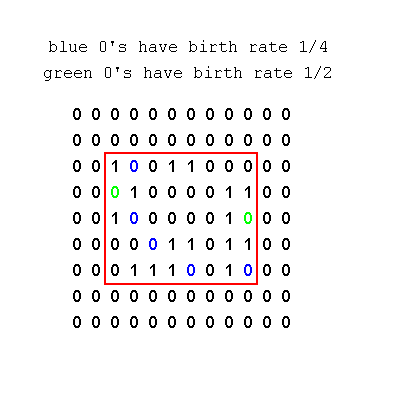
This is sometimes called Schlogl's second model. See Schlogl (1972) and Grassberger (1982). Again 0 = vacant and 1 = occupied, but now it takes two particles to make a new one.
(i) An occupied becomes vacant at a rate delta.
(ii) A vacant site becomes occupied at a rate equal to k/4 where k is number of diagonally adjacent pairs of occupied neighbors.

The Critical Value for Survival is 0. If the initial configuration starts inside a rectangle it can never give birth outside of the rectangle and hence is doomed to die out whenever delta is positive.
Somewhat surprisingly, the Critical Value for Equilibrium is positive. Bramson and Gray (1991) showed that if delta is small enough then the limit starting from all 1's is a nontrivial stationary distribution.
s3 Exercises. To get a feeling for the critical value for survival set delta = 0.075 and start the system from a 25 by 25 rectangle of 0's in a sea of 1's and watch it fill in the hole. When delta = 0.125 the hole grows and the system dies out. When delta = 0.1 things go well for a while then ...
When delta < delta_c the system does well when the density of 1's is large enough. However, it always has trouble when the density is small. H.N. Chen (1992) has shown that if we start from product measure with a small density p (i.e., sites are independently occupied with probability p) then P( state_t[x] = 1) tends to 0 for all x.
s3 Exercise. To see this in a simulation set delta = 0.05 which is well below the critical value. When p = 0.2 the system dies out, but when p = 0.3 it approaches equilbrium. In between at p = 0.25 the pictures are the most interesting.
Schlogl, F. (1972) Chemical reaction models for non-equilibrium phase transitions. Z. Physik 253, 147--161
Grassberger, P. (1982) On phase transitions in Schlogl's second model. Z. Phys. B. 47, 365--376
Bramson, M. and Gray, L. (1991) A useful renormalization argument. Random Walks, Brownian Motion, and Intracting Brownian Motion. Edited by R. Durett and H. Kesten. Birkhauser, Boston.
Chen, H.N. (1992) On the stability of a population growth model with sexual reproduction on Z^2. Ann. Probab. 20, 232-285